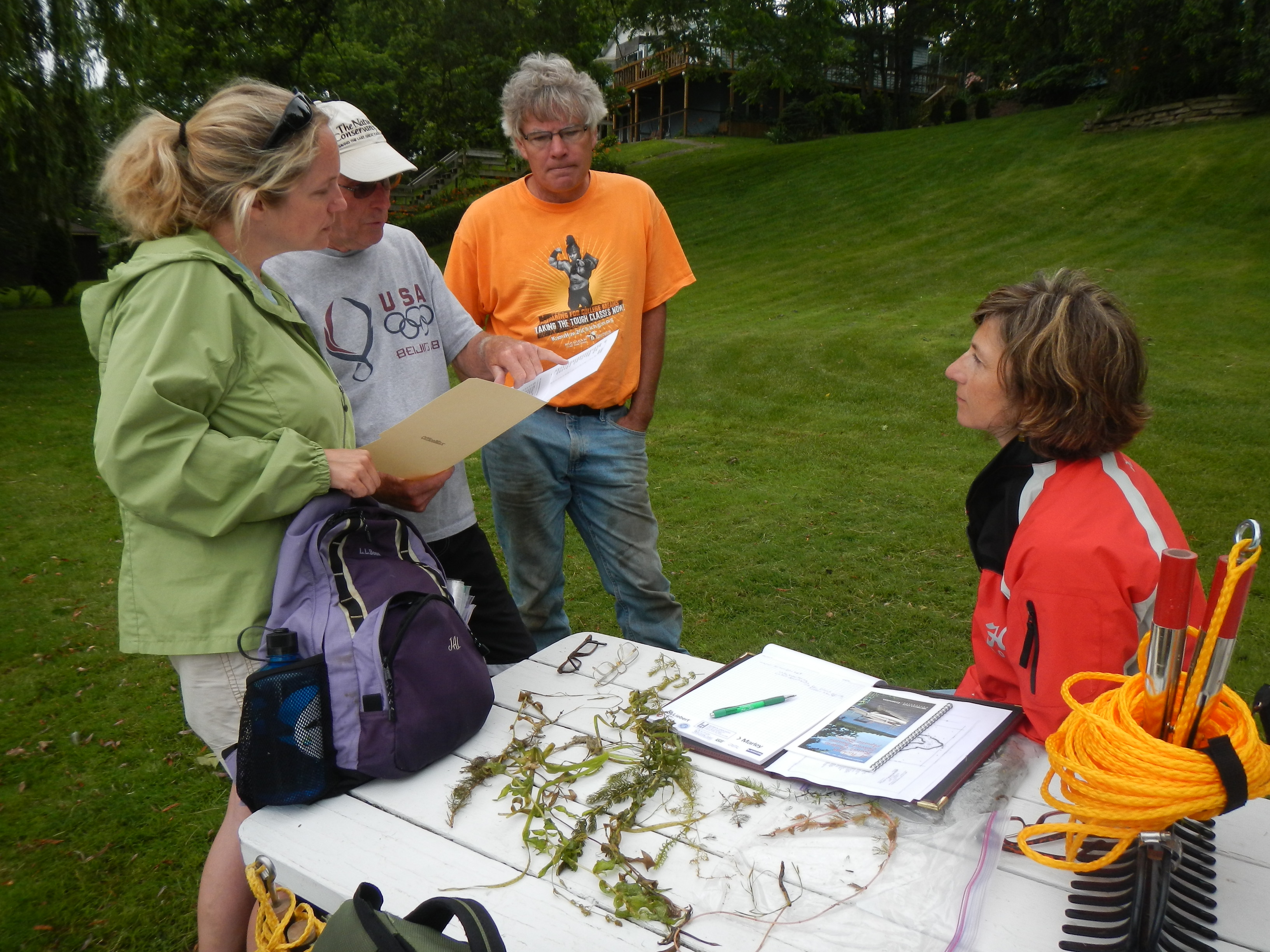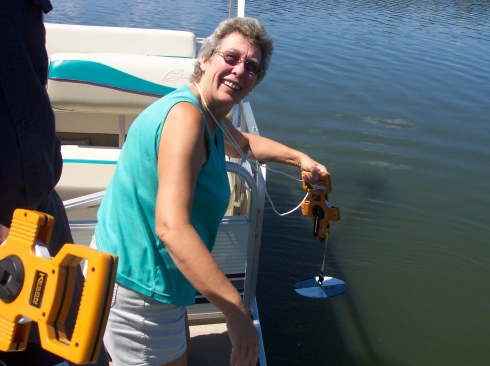Equipping 'Citizen Scientists' to Protect the Lakes and Streams They Love
- Jo Latimore, Ph.D.
- Senior Specialist, Department of Fisheries and Wildlife
- Director, Michigan Clean Water Corps
- College of Agriculture and Natural Resources
Project Overview
- MiCorps is a statewide monitoring program that trains "citizen scientists" to collect water quality data used by local communities and state agencies to manage and protect the state's lakes and streams.
- Grants provide support for local communities to host stream cleanup events to remove trash from rivers.
Products/Outcomes
- Provide high-quality data for Michigan communities and Michigan's Department of Environment, Great Lakes, and Energy (EGLE), Department of Natural Resources, and U.S. Forest Service used to support decisions on how to manage and improve lakes and streams.
- Prevent, detect, and eradicate invasive species in Michigan's streams and lakes.
- Educate the public about water-quality issues and promote stewardship of aquatic ecosystems.
Partners
- Michigan Department of Environment, Great Lakes, and Energy (EGLE)
- Huron River Watershed Council
- Michigan Lakes and Streams Associations
- Local watershed councils and lake associations
- Cooperative Lakes Monitoring Program volunteers
- Volunteer Stream Monitoring Program
Form(s) of Engagement
- Community-Engaged Service
- Community-Engaged Teaching and Learning

Latimore helps volunteers with the Cooperative Lakes Monitoring Program identify plants and differentiate between native and invasive species.
As an MSU aquatic ecologist, Jo Latimore visits hundreds of lakes and streams each year.
But the one closest to the heart is a tiny inland lake nestled among bogs and wetlands near a cabin that's been in her family for generations. She vividly recalls days spent lounging on the dock catching baby turtles and bluegills with her dad. "It's just so quiet and so beautiful," Latimore said.
Hers is a love shared by many Michiganders who visit the state's 11,000 lakes and 36,000 miles of streams every year—whether they live on the water, camp, rent a cottage, or spend weekends swimming, paddling, or fishing.
A senior specialist with the Department of Fisheries and Wildlife, Latimore partners with residents and state agencies to protect the health of Michigan's lakes and streams for generations to come. She directs the Michigan Clean Water Corps (MiCorps), a network of lake and stream volunteer monitoring programs funded by the Michigan Department of Environment, Great Lakes, and Energy (EGLE) and led by MSU Extension in partnership with the Huron River Watershed Council and the Michigan Lakes and Streams Association.
The spring and summer months find her riding in boats or wading in streams, where she works alongside "citizen scientists" who gather data on water quality. She also provides hands-on training about the detection, prevention, and management of invasive species.
"I've always been interested in our lakes and streams, even as a kid, so this is a great way to share that with thousands of other people across the state every year," Latimore said.
Protecting Michigan's Lakes and Streams
Volunteer lake and stream monitoring has a long history in Michigan. The Cooperative Lakes Monitoring Program (CLMP) was established in 1974, making it the second oldest in the U.S. after Minnesota. The Volunteer Stream Monitoring Program began in the mid-1990s.
Both organizations came under the umbrella of MiCorps about 20 years ago. As director, Latimore oversees them along with supporting a Volunteer Stream Cleanup Program.
Roughly 800-1,000 volunteers monitor 300 lakes; hundreds more monitor streams, often at events organized by local watershed councils or conservation groups. These citizen scientists collect water-quality data that MiCorps makes available on its website.
To ensure that the data is sound, MiCorps annually trains volunteers and equips them with precise protocols. If those protocols are not followed, the data is rejected.
"So what we end up with is really high-quality data," Latimore said. "Through our volunteer network, we're able to collect more data on our lakes and streams than any of our agencies can."
That is why EGLE invests in the program, Latimore said. Not only EGLE, but the DNR, the U.S. Forest Service, and MSU researchers benefit. "The goal is to make sure that we're collecting data that can be used to make management decisions or protection decisions about our lakes and streams across the state," she said.
For example, the DNR may want to know which lakes have good fish habitats to decide where to stock fish or promote recreational fishing. Using MiCorps data, it can identify lakes where invasive plants have impeded the fish habitat and make treatment decisions to improve them.
Latimore also has collaborated with MSU scientists and professors, providing reliable data that can assist them in their research or be used in the classroom.
Testing the Waters
On a day-to-day basis, Latimore interacts with hundreds of volunteers across Michigan. "I get to visit a lot of our lakes and rivers around the state," she said. "We go out on boats, and I teach folks how to collect water samples. We do a lot of work on invasive species monitoring and plant monitoring in the lakes."
Each spring, two weeks after the ice melts, lake volunteers bundle up and collect a water sample to measure phosphorous levels. "The protocol is to take a sterile bottle and lean over the side of the boat and plunge your hand in the water up to the elbow...the water is usually about 45 degrees," Latimore said. "It can be pretty chilly."
A high level of phosphorous can cause excess algae and weed growth.
That's just one example of the data lake volunteers collect throughout the spring and summer. They also measure water clarity, chlorophyll a (an indicator of algae growth), and dissolved oxygen and temperature (which affect the ability of aquatic life to thrive).
MiCorps also trains volunteers to identify invasive species. "We've got volunteers out there being the eyes on the water to look for new infestations, particularly plants," Latimore said. "That's the biggest issue in our lakes: invasive plants that make our lakes super weedy because [they] can spread and grow so much faster than any native vegetation."
Mike Gallagher, treasurer of the Michigan Lakes and Streams Association, lives on Gull Lake. He met Latimore 10 to 15 years ago when he became a lake monitor. "Jo is an excellent educator," he said.
One year, for example, he volunteered to do an aquatic vegetation survey. Latimore trained Gallagher and other volunteers to identify the plants growing in their lakes and differentiate native plants from invasive species.
A few years later, a neighbor called Gallagher and asked him to look at some weeds near his dock. "It was a real harmful invasive species," he said. "We did what we were taught: early detection, rapid response."
Armed with that knowledge, the lake association has been able to contain the weeds. The association also installed a boat wash station to prevent invasive species from hitchhiking in bilge water and on propellers from one lake to another.
"We're very, very lucky that we have this big team of volunteers with these scientists leading the volunteers," Gallagher said. "Unless you measure what's going on, you don't really know if things are getting better or worse."
The data volunteers collect helps residents not only understand what is happening to their water bodies but manage them effectively.
Residents may observe that "the lake's not as healthy as it used to be. The water is not as clear as it used to be. It's a lot weedier than it was before," Latimore said. However, without data to back up those observations, it can be challenging to convince a community to contribute toward improving the lake.
"We find that education leads to better local management and also many of our volunteers become more involved in their community," she said. "They're more likely to be a voice and a steward for these water bodies."

Latimore often rides along with volunteers to teach them about invasive species and demonstrate protocols for collecting water samples.

A MiCorps volunteer lowers a patterned Secchi disk into Hicks Lake in Osceola County to measure water clarity. A tape measure is used to determine at what depth the disk is no longer visible.

Stream monitors clad in waders use special nets to collect invertebrates in Augusta Creek. The number and type of invertebrates they find is indicative of the level of pollution in the water.
Stream Science
Stream monitoring is another important aspect of Latimore's work. Rapid development is among the biggest threats. Building roads near streams provides a pathway for pollutants. "Think about when it rains," she said. "All the water comes down, hits those hard surfaces, and washes straight into the creeks and rivers."
MiCorps offers grants, equipment, and training to watershed councils and conservation districts, which enlist volunteers to collect invertebrates such as snails, crayfish, and insects. "Invertebrates are a really good indicator of the health of the stream," Latimore said. "They're not that difficult to catch and identify—you can get some really meaningful data with a half hour's worth of sampling in the stream."
Heather Smith coordinates volunteer stream monitoring, advocacy, and policy work for The Watershed Center Grand Traverse Bay. She is the Grand Traverse Baykeeper, part of a network of Waterkeepers worldwide who advocate for swimmable, fishable, and drinkable water.
The Watershed Center's stream monitoring program includes 100 volunteers who monitor 25 to 30 sites. Twice a year in June and October, teams collect data on invertebrates to calculate a water quality rating for each stream.
"We look to Jo and other MiCorps staff for guidance," said Smith. "We certainly would not have had the caliber of program that we have without their leadership."
For Latimore, the most rewarding aspect of her job is helping volunteers collect and interpret the data. "I get to go out and see these water bodies—lakes and streams that people care about so much. This is one way that people who volunteer are giving back and trying to support and be stewards of these water bodies. It's inspiring every day to work with them."
- Written by Patricia Mish, University Outreach and Engagement
- Photographs courtesy of Jo Latimore